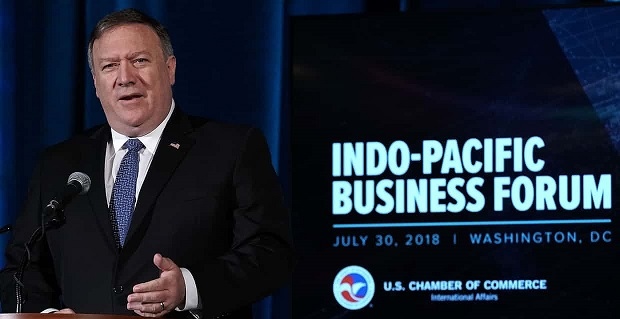US’s Indo-Pacific plan
July 31, 2018 | Expert Insights

US Secretary of State Mike Pompeo at the Indo-Pacific Business Forum in Washington revealed America’s infrastructure development plan for the Indo-Pacific region.
Background
The Trans-Pacific Partnership was a free trade agreement between countries bordering the Pacific Ocean.At the time, it was the largest trade agreement in history and the 12 nations comprised 40% of world trade.However, the future of the deal came into question after the election of President Donald Trump. Trump opposed multilateral trade pacts during his time on the campaign trail. He backed out of the agreement in January 2017. The TPP was restructured by the remaining 11 countries to form the Comprehensive and Progressive Agreement for Trans-Pacific Partnership (CPTPP) in March 2018.
China’s Belt and Road Initiative (BRI or OBOR) was announced in 2013. Hailed as a “21st Century Silk Road”, the initiative seeks to revive trade routes across Eurasia. BRI is said to be a development strategy that involves huge amounts of physical infrastructure. According to the World Bank, OBOR has the potential to include “65 countries, 4.4 billion people, and about 40% of the global GDP”.It is part of China’s strategy for economic diplomacy as it underlines China’s goal to undertake a larger role in global affairs.
The ongoing trade war between US and China has seen severe escalations in the past few months.Last month, the White House announced plans to stick 25% tariffs on 1100 Chinese goods. Beijing vowed to retaliate with the same value: 25% tariffs on US products worth $34 billion per year. China on 11th July vowed to take “countermeasures” after the United States announced 10% tariffs on an extra US$200 billion worth of Chinese imports. US President Trump said he is ready to intensify his trade war with China by slapping tariffs on all $500bn of imports from the country.
Analysis
The US government is expanding its infrastructure drive in the Asia-Pacific region using new investment programmes amid rising anxiety about China’s aggressive overseas development policies. Secretary of State Mike Pompeo at the Indo-Pacific Business Forum on Monday, announced an initiative concerning the Trump administration’s commitment to engage with countries in the Indo-Pacific region.
In response to China’s ambitious “Belt and Road Initiative” ,Pompeo’s “Indo-Pacific Economic Vision” will increase the financial support that the US government provides to countries in the region through a proposed merged agency, the US International Development Finance Corporation (USIDFC).Along with US$113 million in direct government investment, the plan would double the global spending cap for the development finance corporation to US$60 billion, which could be used to provide private companies with loans for projects overseas.
Brian Hook, senior policy advisor to the US Secretary of State, said"India is a key partner in our efforts to ensure that the entire Indo Pacific region is a region of peace, stability and growing prosperity. We work very closely with India.” The new initiative will be bolstered by a trilateral investment agreement among the US, Japan and Australia.“Where America goes, we seek partnership, not domination. We believe in strategic partnerships, not strategic dependency. The American people and the whole world have a stake in the Indo-Pacific’s peace and prosperity, and that’s why it must be free and open,” Mike Pompeo said.
US will spend US$25 million to expand US technology exports to the region, add nearly US$50 million this year to help countries produce and store their energy resources and create a new assistance network to boost infrastructure development.US Secretary of Commerce Wilbur Ross said,under the new plan, the US, one of the world’s biggest oil and liquid natural gas exporters, could help the Indo-Pacific region overcome its lack of hydrocarbon resources.
Bonnie Glaser, director of the China Power Project at the Centre for Strategic and International Studies, called Pompeo’s initiative a positive vision and said “I don’t think it should be seen as anti-China or anti-BRI strategy.”
However, China does not seem to be threatened by US criticism and initiative.During a visit to the Middle East and Africa in the past week, Xi vowed to seek closer alignment with emerging economies globally and further invest in the BRI.
Counterpoint
Eswar Prasad, a Cornell University trade professor and former head of the IMF’s China division, called the US initiatives small compared with the billions of US dollars in investments that China is pouring into the region. Some analysts see the new programme as an aggressive tactic aimed squarely at China.
Polls in the region have shown that America’s reputation has deteriorated immensely since Trump withdrew the US from the Trans-Pacific Partnership (TPP) free-trade deal, with a growing number of Asian nations questioning Washington’s dependability.
Assessment
Our assessment is that the Indo-Pacific Economic Vision is US initiative to counter Chinese influence in the region. We feel that the US must consider a more proactive trade agenda that targets countries that will be strategically significant to the US in the future and also strengthen rule of law in these countries so they are not susceptible to Chinese bribery. We believe that US’s Indo-Pacific Plan will play a key role in the escalations of the ongoing trade war. We also believe that US needs to show real commitment to development in the region as it is still being questioned after its withdrawal from the TPP.








Comments